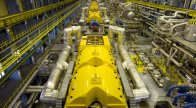On July 7 Atomic Reporters, with the support of Hungary’s IAEA mission, organized a full-day tour of the Paks Nuclear Power Plant (NPP). Eleven Vienna-based journalists representing news organizations from eight different countries took the four hour bus ride to the power plant.
On July 7 Atomic Reporters, with the support of Hungary’s IAEA mission, organized a full-day tour of the Paks Nuclear Power Plant (NPP). Eleven Vienna-based journalists representing news organizations from eight different countries took the four hour bus ride to the power plant.
We were greeted in the visitors’ center by Geza Pekarik, technical director at the NPP. He gave a tailored PowerPoint presentation that provided an overview of the facility, contextualized nuclear power in Hungary’s energy mix and discussed planned construction of two additional reactors.
After the talk, we walked to the plant entrance, where security met us. The guards were friendly and unobtrusive. They had already received our personal data and were prepared before we arrived on site. Once past the sparkling steel gate our group was taken by minivan to the enormous hall housing reactor units 3 and 4.
We saw the domes covering the two reactor vessels. One of the units had been under maintenance and some of the radiation-shielding equipment still was present in the hall. Surrounding the vessel were six hermetically-sealed lids that covered the reactor’s pumps and steam generators, or heat exchangers. Plant personnel pointed out the blue IAEA video cameras monitoring the facility. Two men in white jumpsuits and hardhats were working on the plant floor. Members of our group commented on how orderly and clean the facility looked amid the densely engineered web of tubes and machines.
Next stop was the control room. This is the place where visitors recognize they are inside a 40-year-old facility. Not many fancy graphical-user interfaces here. The four operators in the room sat before drab green control panels populated with buttons and switches. Pathways of colored lights were embedded in the walls. A digital monitor blinked real-time power fluctuations. “What a boring job,” remarked one journalist looking at the men behind the glass partition. “It makes covering the Iran talks seem exciting,” said another.
We were shepherded into a freight elevator and hardhats awaited us when we got out. This was the generator hall, the place where condensing steam rips through the turbines that supply Hungary with 51% of the electricity it produces. The noise and vibrations engulfed our party once we entered. Conversation inside was scarce. Exhilarating and a little bit scary to see how much power a measly 3.5% percent enriched uranium can release.
That marked the end of our power plant tour.Unbeknownst to us was that the best was yet to come.
We hopped back onto the minivan and drove a short stretch from the plant to a low-rise building. It was a newly-erected training center, home to a complete VVER reactor disassembled and transported to Paks from Poland. It had never been commissioned and was therefore safe to approach. Hungary uses the facility for maintenance and emergency training for its own plant personnel as well as future operators from nuclear-newcomer states. Walking into the building, we were struck by sharp smells of fresh paint.
It is hard to understate the awe experienced when standing next to a pressure vessel. Twenty-three meters deep with a 3-meter-wide diameter, this was the alloy ingot built to contain a reactor’s fission energy. While some journalists stared into the vessel’s maw, others ventured down a steel stairway to examine the steam generator, where they could shimmy down a narrow shaft marked inside with control numbers. Still other reporters examined two-meter long fuel assemblies and began to understand the complex craftwork needed to safely power a reactor. There were valves as big as a person and bolts greater than a fist. While cognoscente that these were components of potentially-deadly business, the combination of physical and intellectual stimulation they provided reminded some among us of a well-designed and organized playground. The sense of danger and discovery were balanced.
Well over our budgeted time, the Atomic Reporters trip drew to an end. We were treated to Hungarian carp soup in the plant’s cafeteria. Later in the afternoon we received a presentation about Hungary’s long-term high-level waste disposal strategy. Even at that late hour — and with 340 kilometers separating us from home in Vienna — the questions continued unabated. It is not often that reporters hear tangible plans from countries intent on confronting and solving the nuclear waste issue.
This was Atomic Reporters first excursion to a nuclear facility. Based on the feedback given, it won’t be our last. Stay tuned.
(Atomic Reporters)


